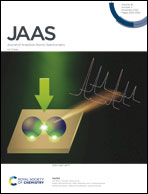In situ XRF study of black colouring matter of the Palaeolithic figures in the Font-de-Gaume cave†
Abstract
The study aims at characterizing prehistoric cave art by a non-invasive approach using portable X-ray fluorescence spectroscopy. Technical difficulties such as restricted access and heterogeneous material are discussed and a reliable, informative protocol was implemented for characterizing the chemical constituents of black figures. Two different data evaluation protocols were compared in the laboratory on mock-up samples with respect to their applicability, limits and deviations, one relying on elemental ratios and the other one on an internal standard. The mock-ups were made of a calcareous substrate and natural manganese oxide minerals likely to be found in the prehistoric cave art. The best-suited data evaluation protocol was applied in situ to 19 analyzed figures in the prehistoric cave of Font-de-Gaume, Dordogne, France. Different chemical groups could be defined among the manganese oxide-based paints and discussed within the cave context. Confirmation of the defined groups could be provided by complementary Raman investigations and they are consistent with chemical groups found in comparable cave art, namely in the Rouffignac cave, Dordogne, France.



 Please wait while we load your content...
Please wait while we load your content...